Abstract
Systemic lupus erythematosus and other chronic systemic autoimmune diseases are associated with circulating autoantibodies reactive with a limited set of mostly nuclear proteins. Using rigorous statistical methods we have identified segments of highly significant charge concentration in the majority of the characteristic nuclear and cytoplasmic autoantigens. Extremely long runs of charged residues, including some sequences of greater than 20 consecutive charged residues (purely acidic or mixed basic and acidic), occur in about a third of these proteins, whereas equivalent runs are found in less than 3% of other mammalian proteins. The other sequences have less extreme charge clusters, the type and location of which are often conserved between several otherwise nonsimilar antigens. We propose that supercharged surfaces render the targeted host proteins strongly immunogenic and that antinuclear antibody profiles might result from chronic exposure to intracellular contents, possibly in conjunction with crossreactive viral products. The limited number of potential systemic autoantigens may partly be due to the rarity of requisite charge properties.
Full text
PDF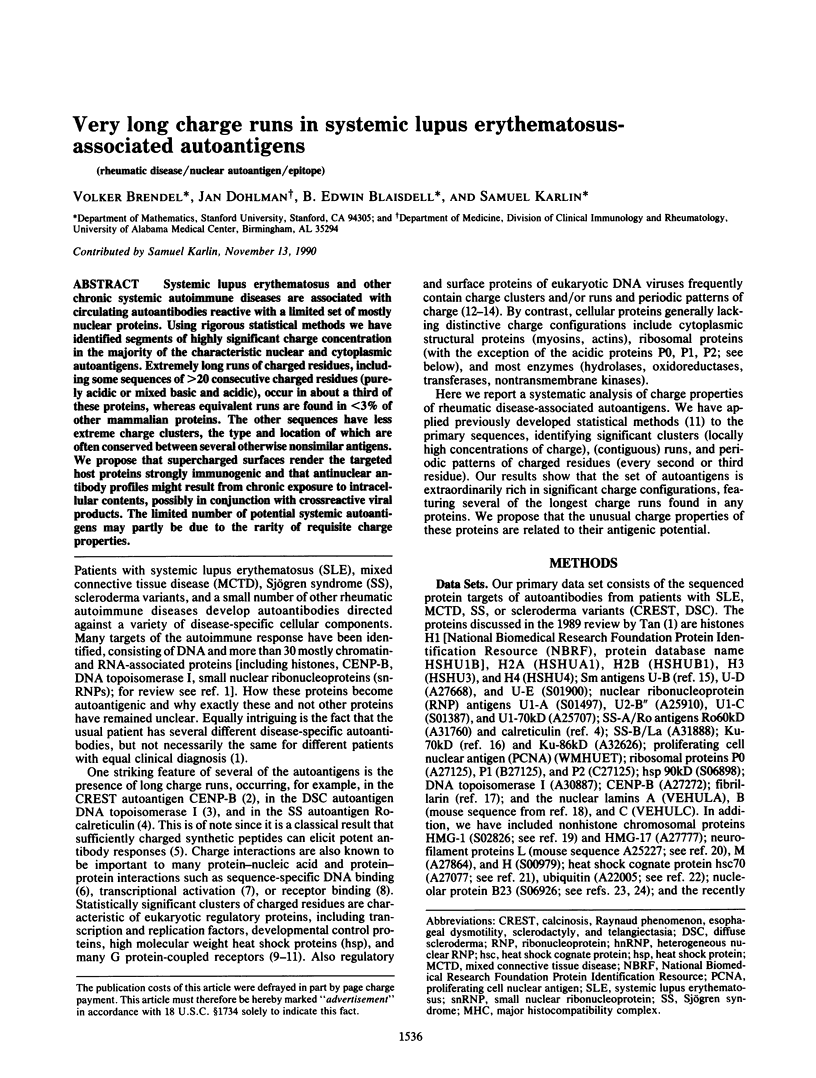
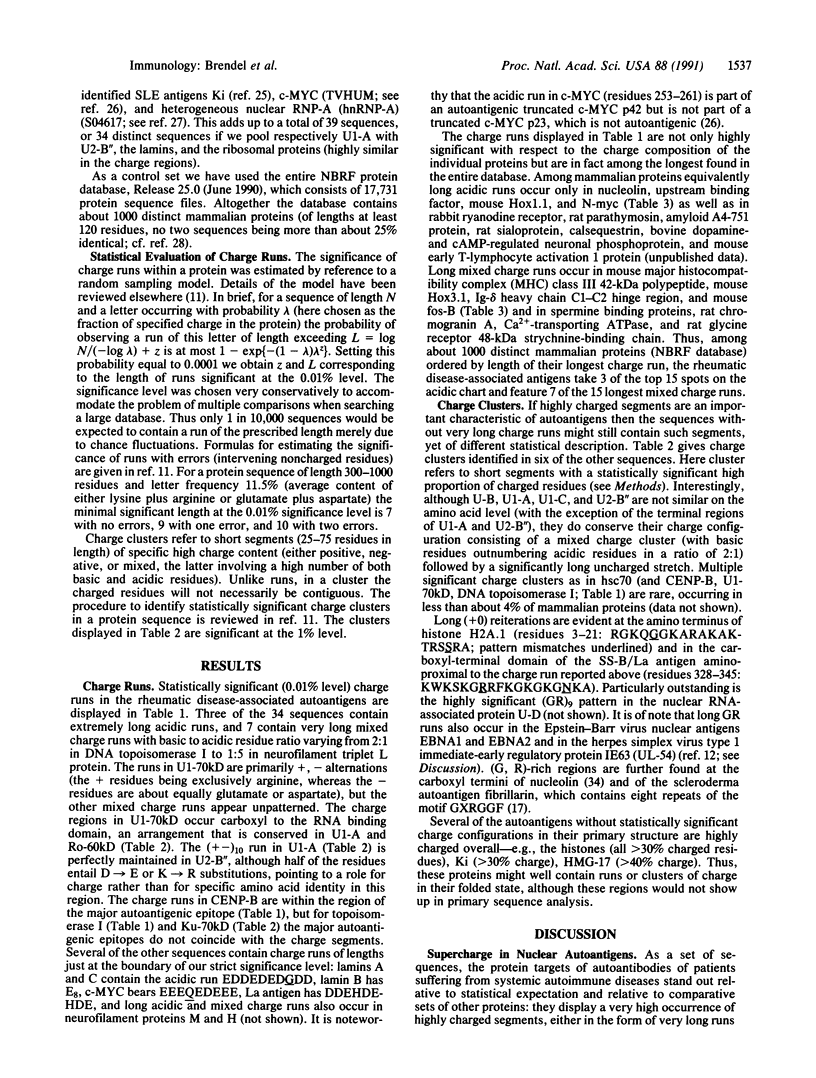
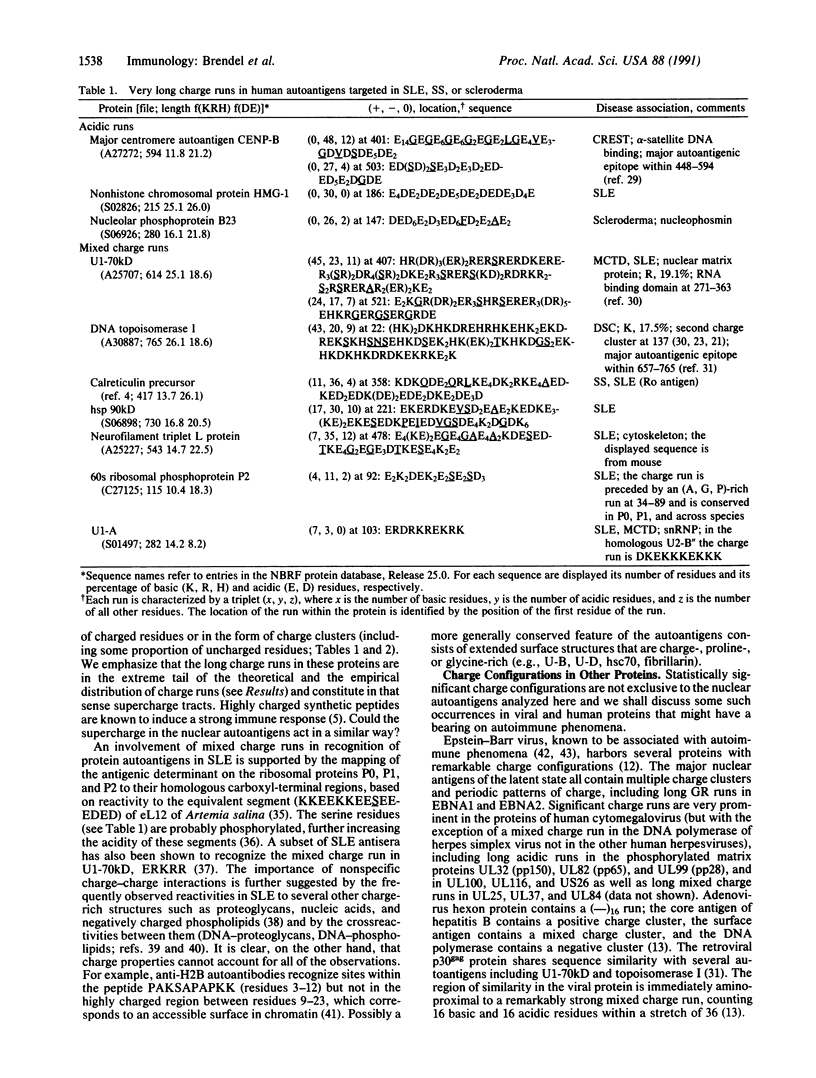
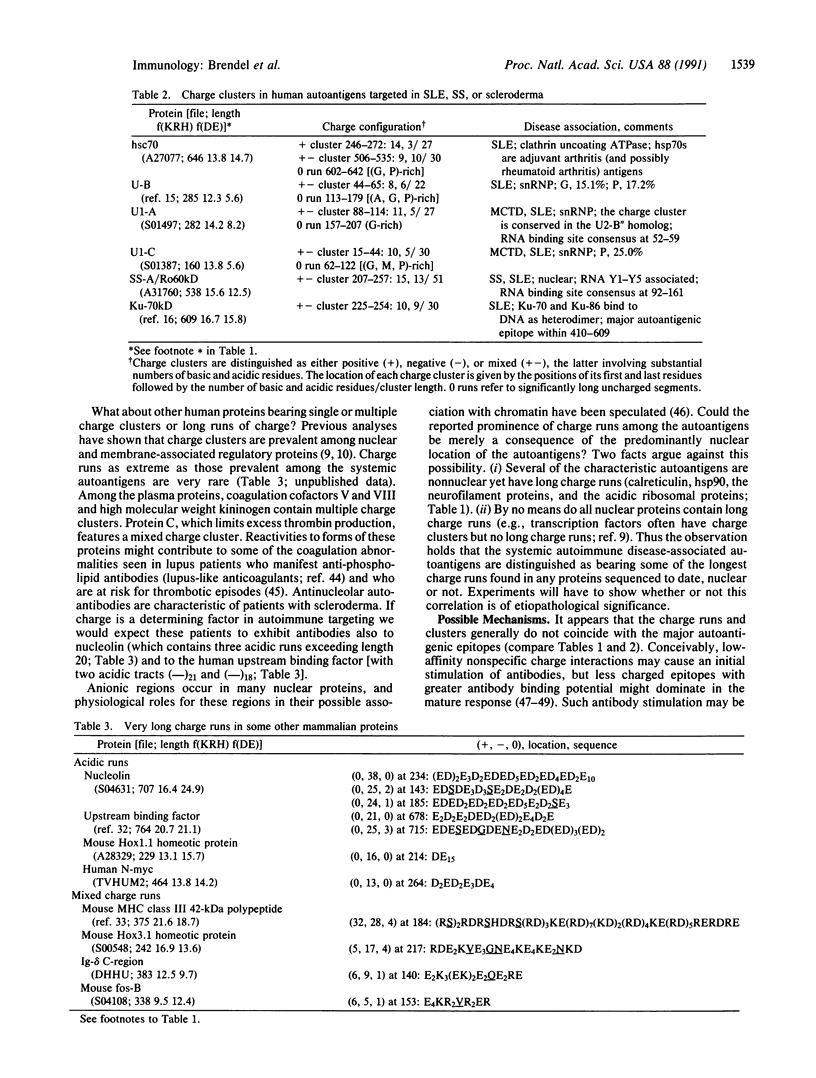
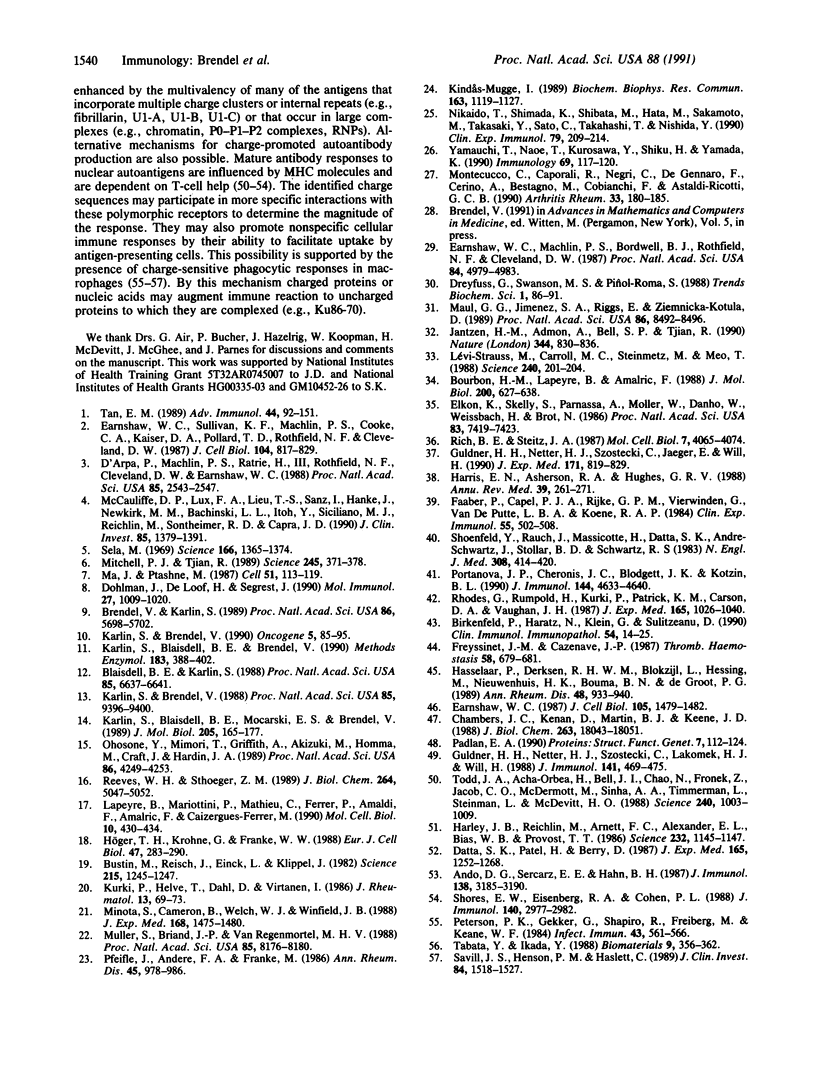
Selected References
These references are in PubMed. This may not be the complete list of references from this article.
- Ando D. G., Sercarz E. E., Hahn B. H. Mechanisms of T and B cell collaboration in the in vitro production of anti-DNA antibodies in the NZB/NZW F1 murine SLE model. J Immunol. 1987 May 15;138(10):3185–3190. [PubMed] [Google Scholar]
- Birkenfeld P., Haratz N., Klein G., Sulitzeanu D. Cross-reactivity between the EBNA-1 p107 peptide, collagen, and keratin: implications for the pathogenesis of rheumatoid arthritis. Clin Immunol Immunopathol. 1990 Jan;54(1):14–25. doi: 10.1016/0090-1229(90)90002-8. [DOI] [PubMed] [Google Scholar]
- Blaisdell B. E., Karlin S. Distinctive charge configurations in proteins of the Epstein-Barr virus and possible functions. Proc Natl Acad Sci U S A. 1988 Sep;85(18):6637–6641. doi: 10.1073/pnas.85.18.6637. [DOI] [PMC free article] [PubMed] [Google Scholar]
- Bourbon H. M., Lapeyre B., Amalric F. Structure of the mouse nucleolin gene. The complete sequence reveals that each RNA binding domain is encoded by two independent exons. J Mol Biol. 1988 Apr 20;200(4):627–638. doi: 10.1016/0022-2836(88)90476-7. [DOI] [PubMed] [Google Scholar]
- Brendel V., Karlin S. Association of charge clusters with functional domains of cellular transcription factors. Proc Natl Acad Sci U S A. 1989 Aug;86(15):5698–5702. doi: 10.1073/pnas.86.15.5698. [DOI] [PMC free article] [PubMed] [Google Scholar]
- Bustin M., Reisch J., Einck L., Klippel J. H. Autoantibodies to nucleosomal proteins: antibodies to HMG-17 in autoimmune diseases. Science. 1982 Mar 5;215(4537):1245–1247. doi: 10.1126/science.6460317. [DOI] [PubMed] [Google Scholar]
- Chambers J. C., Kenan D., Martin B. J., Keene J. D. Genomic structure and amino acid sequence domains of the human La autoantigen. J Biol Chem. 1988 Dec 5;263(34):18043–18051. [PubMed] [Google Scholar]
- D'Arpa P., Machlin P. S., Ratrie H., 3rd, Rothfield N. F., Cleveland D. W., Earnshaw W. C. cDNA cloning of human DNA topoisomerase I: catalytic activity of a 67.7-kDa carboxyl-terminal fragment. Proc Natl Acad Sci U S A. 1988 Apr;85(8):2543–2547. doi: 10.1073/pnas.85.8.2543. [DOI] [PMC free article] [PubMed] [Google Scholar]
- Datta S. K., Patel H., Berry D. Induction of a cationic shift in IgG anti-DNA autoantibodies. Role of T helper cells with classical and novel phenotypes in three murine models of lupus nephritis. J Exp Med. 1987 May 1;165(5):1252–1268. doi: 10.1084/jem.165.5.1252. [DOI] [PMC free article] [PubMed] [Google Scholar]
- Dohlman J. G., De Loof H., Segrest J. P. Charge distributions and amphipathicity of receptor-binding alpha-helices. Mol Immunol. 1990 Oct;27(10):1009–1020. doi: 10.1016/0161-5890(90)90124-i. [DOI] [PubMed] [Google Scholar]
- Dreyfuss G., Swanson M. S., Piñol-Roma S. Heterogeneous nuclear ribonucleoprotein particles and the pathway of mRNA formation. Trends Biochem Sci. 1988 Mar;13(3):86–91. doi: 10.1016/0968-0004(88)90046-1. [DOI] [PubMed] [Google Scholar]
- Earnshaw W. C. Anionic regions in nuclear proteins. J Cell Biol. 1987 Oct;105(4):1479–1482. doi: 10.1083/jcb.105.4.1479. [DOI] [PMC free article] [PubMed] [Google Scholar]
- Earnshaw W. C., Machlin P. S., Bordwell B. J., Rothfield N. F., Cleveland D. W. Analysis of anticentromere autoantibodies using cloned autoantigen CENP-B. Proc Natl Acad Sci U S A. 1987 Jul;84(14):4979–4983. doi: 10.1073/pnas.84.14.4979. [DOI] [PMC free article] [PubMed] [Google Scholar]
- Earnshaw W. C., Sullivan K. F., Machlin P. S., Cooke C. A., Kaiser D. A., Pollard T. D., Rothfield N. F., Cleveland D. W. Molecular cloning of cDNA for CENP-B, the major human centromere autoantigen. J Cell Biol. 1987 Apr;104(4):817–829. doi: 10.1083/jcb.104.4.817. [DOI] [PMC free article] [PubMed] [Google Scholar]
- Elkon K., Skelly S., Parnassa A., Moller W., Danho W., Weissbach H., Brot N. Identification and chemical synthesis of a ribosomal protein antigenic determinant in systemic lupus erythematosus. Proc Natl Acad Sci U S A. 1986 Oct;83(19):7419–7423. doi: 10.1073/pnas.83.19.7419. [DOI] [PMC free article] [PubMed] [Google Scholar]
- Faaber P., Capel P. J., Rijke G. P., Vierwinden G., van de Putte L. B., Koene R. A. Cross-reactivity of anti-DNA antibodies with proteoglycans. Clin Exp Immunol. 1984 Mar;55(3):502–508. [PMC free article] [PubMed] [Google Scholar]
- Freyssinet J. M., Cazenave J. P. Lupus-like anticoagulants, modulation of the protein C pathway and thrombosis. Thromb Haemost. 1987 Aug 4;58(2):679–681. [PubMed] [Google Scholar]
- Guldner H. H., Netter H. J., Szostecki C., Jaeger E., Will H. Human anti-p68 autoantibodies recognize a common epitope of U1 RNA containing small nuclear ribonucleoprotein and influenza B virus. J Exp Med. 1990 Mar 1;171(3):819–829. doi: 10.1084/jem.171.3.819. [DOI] [PMC free article] [PubMed] [Google Scholar]
- Guldner H. H., Netter H. J., Szostecki C., Lakomek H. J., Will H. Epitope mapping with a recombinant human 68-kDa (U1) ribonucleoprotein antigen reveals heterogeneous autoantibody profiles in human autoimmune sera. J Immunol. 1988 Jul 15;141(2):469–475. [PubMed] [Google Scholar]
- Harley J. B., Reichlin M., Arnett F. C., Alexander E. L., Bias W. B., Provost T. T. Gene interaction at HLA-DQ enhances autoantibody production in primary Sjögren's syndrome. Science. 1986 May 30;232(4754):1145–1147. doi: 10.1126/science.3458307. [DOI] [PubMed] [Google Scholar]
- Harris E. N., Asherson R. A., Hughes G. R. Antiphospholipid antibodies--autoantibodies with a difference. Annu Rev Med. 1988;39:261–271. doi: 10.1146/annurev.me.39.020188.001401. [DOI] [PubMed] [Google Scholar]
- Hasselaar P., Derksen R. H., Blokzijl L., Hessing M., Nieuwenhuis H. K., Bouma B. N., De Groot P. G. Risk factors for thrombosis in lupus patients. Ann Rheum Dis. 1989 Nov;48(11):933–940. doi: 10.1136/ard.48.11.933. [DOI] [PMC free article] [PubMed] [Google Scholar]
- Höger T. H., Krohne G., Franke W. W. Amino acid sequence and molecular characterization of murine lamin B as deduced from cDNA clones. Eur J Cell Biol. 1988 Dec;47(2):283–290. [PubMed] [Google Scholar]
- Jantzen H. M., Admon A., Bell S. P., Tjian R. Nucleolar transcription factor hUBF contains a DNA-binding motif with homology to HMG proteins. Nature. 1990 Apr 26;344(6269):830–836. doi: 10.1038/344830a0. [DOI] [PubMed] [Google Scholar]
- Karlin S., Blaisdell B. E., Brendel V. Identification of significant sequence patterns in proteins. Methods Enzymol. 1990;183:388–402. doi: 10.1016/0076-6879(90)83026-6. [DOI] [PubMed] [Google Scholar]
- Karlin S., Blaisdell B. E., Mocarski E. S., Brendel V. A method to identify distinctive charge configurations in protein sequences, with application to human herpesvirus polypeptides. J Mol Biol. 1989 Jan 5;205(1):165–177. doi: 10.1016/0022-2836(89)90373-2. [DOI] [PubMed] [Google Scholar]
- Karlin S., Brendel V. Charge configurations in oncogene products and transforming proteins. Oncogene. 1990 Jan;5(1):85–95. [PubMed] [Google Scholar]
- Karlin S., Brendel V. Charge configurations in viral proteins. Proc Natl Acad Sci U S A. 1988 Dec;85(24):9396–9400. doi: 10.1073/pnas.85.24.9396. [DOI] [PMC free article] [PubMed] [Google Scholar]
- Kindås-Mügge I. Human autoantibodies against a nucleolar protein. Biochem Biophys Res Commun. 1989 Sep 15;163(2):1119–1127. doi: 10.1016/0006-291x(89)92337-1. [DOI] [PubMed] [Google Scholar]
- Kurki P., Helve T., Dahl D., Virtanen I. Neurofilament antibodies in systemic lupus erythematosus. J Rheumatol. 1986 Feb;13(1):69–73. [PubMed] [Google Scholar]
- Lapeyre B., Mariottini P., Mathieu C., Ferrer P., Amaldi F., Amalric F., Caizergues-Ferrer M. Molecular cloning of Xenopus fibrillarin, a conserved U3 small nuclear ribonucleoprotein recognized by antisera from humans with autoimmune disease. Mol Cell Biol. 1990 Jan;10(1):430–434. doi: 10.1128/mcb.10.1.430. [DOI] [PMC free article] [PubMed] [Google Scholar]
- Lévi-Strauss M., Carroll M. C., Steinmetz M., Meo T. A previously undetected MHC gene with an unusual periodic structure. Science. 1988 Apr 8;240(4849):201–204. doi: 10.1126/science.3353717. [DOI] [PubMed] [Google Scholar]
- Ma J., Ptashne M. A new class of yeast transcriptional activators. Cell. 1987 Oct 9;51(1):113–119. doi: 10.1016/0092-8674(87)90015-8. [DOI] [PubMed] [Google Scholar]
- Maul G. G., Jimenez S. A., Riggs E., Ziemnicka-Kotula D. Determination of an epitope of the diffuse systemic sclerosis marker antigen DNA topoisomerase I: sequence similarity with retroviral p30gag protein suggests a possible cause for autoimmunity in systemic sclerosis. Proc Natl Acad Sci U S A. 1989 Nov;86(21):8492–8496. doi: 10.1073/pnas.86.21.8492. [DOI] [PMC free article] [PubMed] [Google Scholar]
- McCauliffe D. P., Lux F. A., Lieu T. S., Sanz I., Hanke J., Newkirk M. M., Bachinski L. L., Itoh Y., Siciliano M. J., Reichlin M. Molecular cloning, expression, and chromosome 19 localization of a human Ro/SS-A autoantigen. J Clin Invest. 1990 May;85(5):1379–1391. doi: 10.1172/JCI114582. [DOI] [PMC free article] [PubMed] [Google Scholar]
- Minota S., Cameron B., Welch W. J., Winfield J. B. Autoantibodies to the constitutive 73-kD member of the hsp70 family of heat shock proteins in systemic lupus erythematosus. J Exp Med. 1988 Oct 1;168(4):1475–1480. doi: 10.1084/jem.168.4.1475. [DOI] [PMC free article] [PubMed] [Google Scholar]
- Mitchell P. J., Tjian R. Transcriptional regulation in mammalian cells by sequence-specific DNA binding proteins. Science. 1989 Jul 28;245(4916):371–378. doi: 10.1126/science.2667136. [DOI] [PubMed] [Google Scholar]
- Montecucco C., Caporali R., Negri C., de Gennaro F., Cerino A., Bestagno M., Cobianchi F., Astaldi-Ricotti G. C. Antibodies from patients with rheumatoid arthritis and systemic lupus erythematosus recognize different epitopes of a single heterogeneous nuclear RNP core protein. Possible role of cross-reacting antikeratin antibodies. Arthritis Rheum. 1990 Feb;33(2):180–186. doi: 10.1002/art.1780330205. [DOI] [PubMed] [Google Scholar]
- Muller S., Briand J. P., Van Regenmortel M. H. Presence of antibodies to ubiquitin during the autoimmune response associated with systemic lupus erythematosus. Proc Natl Acad Sci U S A. 1988 Nov;85(21):8176–8180. doi: 10.1073/pnas.85.21.8176. [DOI] [PMC free article] [PubMed] [Google Scholar]
- Nikaido T., Shimada K., Shibata M., Hata M., Sakamoto M., Takasaki Y., Sato C., Takahashi T., Nishida Y. Cloning and nucleotide sequence of cDNA for Ki antigen, a highly conserved nuclear protein detected with sera from patients with systemic lupus erythematosus. Clin Exp Immunol. 1990 Feb;79(2):209–214. doi: 10.1111/j.1365-2249.1990.tb05180.x. [DOI] [PMC free article] [PubMed] [Google Scholar]
- Ohosone Y., Mimori T., Griffith A., Akizuki M., Homma M., Craft J., Hardin J. A. Molecular cloning of cDNA encoding Sm autoantigen: derivation of a cDNA for a B polypeptide of the U series of small nuclear ribonucleoprotein particles. Proc Natl Acad Sci U S A. 1989 Jun;86(11):4249–4253. doi: 10.1073/pnas.86.11.4249. [DOI] [PMC free article] [PubMed] [Google Scholar]
- Padlan E. A. On the nature of antibody combining sites: unusual structural features that may confer on these sites an enhanced capacity for binding ligands. Proteins. 1990;7(2):112–124. doi: 10.1002/prot.340070203. [DOI] [PubMed] [Google Scholar]
- Peterson P. K., Gekker G., Shapiro R., Freiberg M., Keane W. F. Polyamino acid enhancement of bacterial phagocytosis by human polymorphonuclear leukocytes and peritoneal macrophages. Infect Immun. 1984 Feb;43(2):561–566. doi: 10.1128/iai.43.2.561-566.1984. [DOI] [PMC free article] [PubMed] [Google Scholar]
- Pfeifle J., Anderer F. A., Franke M. Characterisation of nucleolar proteins as autoantigens using human autoimmune sera. Ann Rheum Dis. 1986 Dec;45(12):978–986. doi: 10.1136/ard.45.12.978. [DOI] [PMC free article] [PubMed] [Google Scholar]
- Portanova J. P., Cheronis J. C., Blodgett J. K., Kotzin B. L. Histone autoantigens in murine lupus. Definition of a major epitope within an accessible region of chromatin. J Immunol. 1990 Jun 15;144(12):4633–4640. [PubMed] [Google Scholar]
- Reeves W. H., Sthoeger Z. M. Molecular cloning of cDNA encoding the p70 (Ku) lupus autoantigen. J Biol Chem. 1989 Mar 25;264(9):5047–5052. [PubMed] [Google Scholar]
- Rhodes G., Rumpold H., Kurki P., Patrick K. M., Carson D. A., Vaughan J. H. Autoantibodies in infectious mononucleosis have specificity for the glycine-alanine repeating region of the Epstein-Barr virus nuclear antigen. J Exp Med. 1987 Apr 1;165(4):1026–1040. doi: 10.1084/jem.165.4.1026. [DOI] [PMC free article] [PubMed] [Google Scholar]
- Rich B. E., Steitz J. A. Human acidic ribosomal phosphoproteins P0, P1, and P2: analysis of cDNA clones, in vitro synthesis, and assembly. Mol Cell Biol. 1987 Nov;7(11):4065–4074. doi: 10.1128/mcb.7.11.4065. [DOI] [PMC free article] [PubMed] [Google Scholar]
- Savill J. S., Henson P. M., Haslett C. Phagocytosis of aged human neutrophils by macrophages is mediated by a novel "charge-sensitive" recognition mechanism. J Clin Invest. 1989 Nov;84(5):1518–1527. doi: 10.1172/JCI114328. [DOI] [PMC free article] [PubMed] [Google Scholar]
- Sela M. Antigenicity: some molecular aspects. Science. 1969 Dec 12;166(3911):1365–1374. doi: 10.1126/science.166.3911.1365. [DOI] [PubMed] [Google Scholar]
- Shoenfeld Y., Rauch J., Massicotte H., Datta S. K., André-Schwartz J., Stollar B. D., Schwartz R. S. Polyspecificity of monoclonal lupus autoantibodies produced by human-human hybridomas. N Engl J Med. 1983 Feb 24;308(8):414–420. doi: 10.1056/NEJM198302243080802. [DOI] [PubMed] [Google Scholar]
- Shores E. W., Eisenberg R. A., Cohen P. L. T-B collaboration in the in vitro anti-Sm autoantibody response of MRL/Mp-lpr/lpr mice. J Immunol. 1988 May 1;140(9):2977–2982. [PubMed] [Google Scholar]
- Tabata Y., Ikada Y. Effect of the size and surface charge of polymer microspheres on their phagocytosis by macrophage. Biomaterials. 1988 Jul;9(4):356–362. doi: 10.1016/0142-9612(88)90033-6. [DOI] [PubMed] [Google Scholar]
- Todd J. A., Acha-Orbea H., Bell J. I., Chao N., Fronek Z., Jacob C. O., McDermott M., Sinha A. A., Timmerman L., Steinman L. A molecular basis for MHC class II--associated autoimmunity. Science. 1988 May 20;240(4855):1003–1009. doi: 10.1126/science.3368786. [DOI] [PubMed] [Google Scholar]
- Yamauchi T., Naoe T., Kurosawa Y., Shiku H., Yamada K. Autoantibodies to c-myc nuclear protein products in autoimmune disease. Immunology. 1990 Jan;69(1):117–120. [PMC free article] [PubMed] [Google Scholar]


